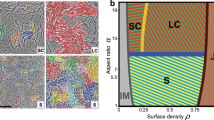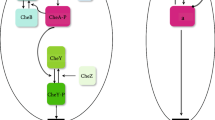Abstract
Changes in the proton-motive force cause a transient change in the motile behavior of Bacillus subtilis cells. Both an increase and a decrease in the proton-motive force cause transient tumbling. Simultaneous decrease of proton-motive force and increase of attractant concentration lessens the response toward the attractant. A simultaneous increase of proton-motive force and increase of attractant concentration prolonges the response toward attractant. A hypothesis explaining the various effects is given.
Similar content being viewed by others
Abbreviations
- KT medium:
-
potassium taxis medium
- NaT medium:
-
sodium taxis medium
- HT medium:
-
acidic taxis medium
- OHT medium:
-
alkaline taxis medium
- DNP:
-
2,4-dinitrophenol
References
Berg, H. C., Brown, D. A.: Chemotaxis in Escherichia coli analysed by three-dimensional tracking. Nature (Lond.) 239, 500–504 (1972)
Borst Pauwels, G. W. F. H., Dobbelman, J.: Determination of the yeast cell pH. Acta bot. neerl. 21, 149–154 (1972)
De Jong, M. H., van der Drift, C., Vogels, G. D.: Receptors for chemotaxis in Bacillus subtilis. J. Bact. 123, 824–827 (1975)
Harold, F. M.: Conservation and transformation of energy by bacterial membranes. Bact. Rev. 36, 172–230 (1972)
Larsen, S. H., Adler, J., Gargus, J. J., Hogg, R. W.: Chemomechanical coupling without ATP. The source of energy for motility and chemotaxis in bacteria. Proc. nat. Acad. Sci. (Wash.) 71, 1239–1243 (1974)
MacNab, R. M., Koshland, D. E., Jr.: The gradient-sensing mechanism in bacterial chemotaxis. Proc. nat. Acad. Sci. (Wash.) 69, 2509–2512 (1972)
Ordal, G. W., Goldman, D. J.: Chemotaxis away from uncouplers of oxidative phosphorylation in Bacillus subtilis. Science 189, 802–805 (1975)
Ordal, G. W., Goldman, D. J.: Chemotactic repellents of Bacillus subtilis. J. molec. Biol. 100, 103–108 (1976)
Springer, M. S., Kort, E. N., Larsen, S. H., Ordal, G. W., Reader, R. W., Adler, J.: Role of methionine in bacterial chemotaxis: Requirement for tumbling and involvement in information processing. Proc. nat. Acad. Sci. (Wash.) 72, 4640–4644 (1975)
Tsang, N., MacNab, R., Koshland, D. E., Jr.: Common mechanism for repellents and attractants in bacterial chemotaxis. Science 181, 60–63 (1973)
Van der Drift, C., de Jong, M. H.: Chemotaxis toward amino acids in Bacillus subtilis. Arch. Microbiol. 96, 83–92 (1974)
Author information
Authors and Affiliations
Rights and permissions
About this article
Cite this article
De Jong, M.H., Van der Drift, C. & Vogels, G.D. Proton-motive force and the motile behavior of Bacillus subtilis . Arch. Microbiol. 111, 7–11 (1976). https://doi.org/10.1007/BF00446543
Received:
Issue Date:
DOI: https://doi.org/10.1007/BF00446543




